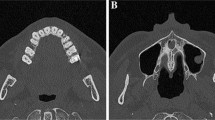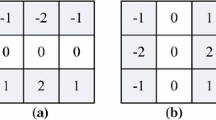Abstract
X-ray CT projection data often include components with frequencies that are markedly higher than the pixel Nyquist frequency f PN, which is determined by the pixel size. Noise components higher than f PN are folded back into a region lower than f PN through the backprojection process, thereby creating aliased noise. With clinical CT scanners, we evaluated the aliased noise using an aliasing prevention measure, band-limiting processing (BLP), which suppresses frequency components higher than f PN in the projection data. Indices we used to evaluate improvement by BLP were the noise power spectrum (NPS), modulation transfer function (MTF), signal-to-noise-ratio (SNR) spectrum, matched filter SNR (MF SNR), and two-alternative forced-choice (2-AFC) test. With BLP, the NPS was decreased not only beyond f PN, but also within f PN. The same level of MTF was maintained as that without BLP within f PN. No remarkable reduction in spatial resolution was observed. The SNR spectrum and the MF SNR of the BLP image nearly agreed with those of an ideal state without aliased noise. A notable improvement in the visuoperceptual image quality by BLP was recognized with a reconstruction field of view (FOV) of more than 45 cm. We then applied BLP to clinical data and confirmed that significant aliased noise of a large FOV image was removed without notable side effects. The results showed that at least some CTs suffering from aliased noise can be improved by proper band-limiting.














Similar content being viewed by others
References
Kijewski MF, Judy PF. The noise power spectrum of CT images. Phys Med Biol. 1987;32:565–75.
Vaz MS, Mersereau R. On Filter Design for CT Reconstruction. In: Proceedings of Tenth International Meeting on Fully Three-Dimensional Image Reconstruction in Radiology and Nuclear Medicine. 2009. pp. 154–57.
Archibald R, Gelb A. A method to reduce the Gibbs ringing artifact in MRI scans while keeping tissue boundary integrity. IEEE Trans Med Imaging. 2002;21:305–19.
Jiang H. Computed Tomography: Principles, Design, Artifacts, and Recent Advances, Second Edition. SPIE Press; 2009. p. 83.
Sato K, Sakamoto H, Goto M, Osanai M, Machida Y, et al. A Method of CT Simulation for Users by Using Projection Data Processing. Bull Sch Health Sci Tohoku Univ. 2011;20:91–102 (in Japanese).
Boedeker KL, Cooper VN, McNitt-Gray MF. Application of the noise power spectrum in modern diagnostic MDCT: part II. Noise power spectra and signal-to-noise. Phys Med Biol. 2007;52:4047–61.
Goto M, Sato K, Minakuchi S, Miura T, Osanai M, et al. Noise Analysis of CT Image: improvement in Low-Frequency Area. Bull Sch Health Sci Tohoku Univ. 2011;20:55–61 (in Japanese).
Jiang H, Chen WR, Liu H. Effect of window function on noise power spectrum measurements in digital X-ray imaging. Proc SPIE. 2002;4615:91–7.
Boedeker KL, Cooper VN, McNitt-Gray MF. Application of the noise power spectrum in modern diagnostic MDCT: part I. Measurement of noise power spectra and noise equivalent quanta. Phys Med Biol. 2007;52:4027–46.
Mori I, Machida Y. Deriving the modulation transfer function of CT from extremely noisy edge profiles. Radiol Phys Technol. 2009;2:22–32.
Richard S, Husarik DB, Yadava G, Murphy SN, Samei E. Towards task-based assessment of CT performance: system and object MTF across different reconstruction algorithms. Med Phys. 2012;39:4115–22.
Ohisa T, Ito M, Sasaki S, Abiko S, Sasaki T, et al. Evaluation of CT-Image (III)—Intercomparison among Different CT Equipment. Bull Coll Med Sci Tohoku Univ. 1995;4:45–52 (in Japanese).
Hara T, Ichikawa K, Sanada S, Ida Y. Image quality dependence on in-plane positions and directions for MDCT images. Eur J Radiol. 2010;75:114–21.
Ichikawa K, Hara T, Niwa S, Yamaguchi I, Ohashi K. Evaluation of low contrast detectability using signal-to-noise ratio in computed tomography. Med Imaging Inf Sci. 2007;24:106–11 (in Japanese).
Loo LN, Doi K, Metz CE. A comparison of physical image quality indices and observer performance in the radiographic detection of nylon beads. Phys Med Biol. 1984;7:837–56.
Richard S, Siewerdsen JH. Comparison of model and human observer performance for detection and discrimination tasks using dual-energy X-ray images. Med Phys. 2008;35:5043–53.
Tward DJ, Siewerdsen JH, Daly MJ, Richard S, Moseley DJ, Jaffray DA, et al. Soft-tissue detectability in cone-beam CT: evaluation by 2AFC tests in relation to physical performance metrics. Med Phys. 2007;34:4459–71.
Herrmann C, Buhr E, Hoeschen D, Fan SY. Comparison of ROC and AFC methods in a visual detection task. Med Phys. 1993;20:805–11.
Tapiovaaraa MJ, SandBorg M. How should low-contrast detail detectability be measured in fluoroscopy? Med Phys. 2004;31:2564–76.
Reiser I, Nishikawa MR. Identification of simulated microcalcifications in white noise and mammographic backgrounds. Med Phys. 2006;33:2905–11.
Acknowledgments
This work was supported by JSPS KAKENHI Grant Number 21591591.
Conflict of interest
The authors declare that they have no conflict of interest.
Author information
Authors and Affiliations
Corresponding author
About this article
Cite this article
Sato, K., Shidahara, M., Goto, M. et al. Aliased noise in X-ray CT images and band-limiting processing as a preventive measure. Radiol Phys Technol 8, 178–192 (2015). https://doi.org/10.1007/s12194-015-0306-5
Received:
Revised:
Accepted:
Published:
Issue Date:
DOI: https://doi.org/10.1007/s12194-015-0306-5




